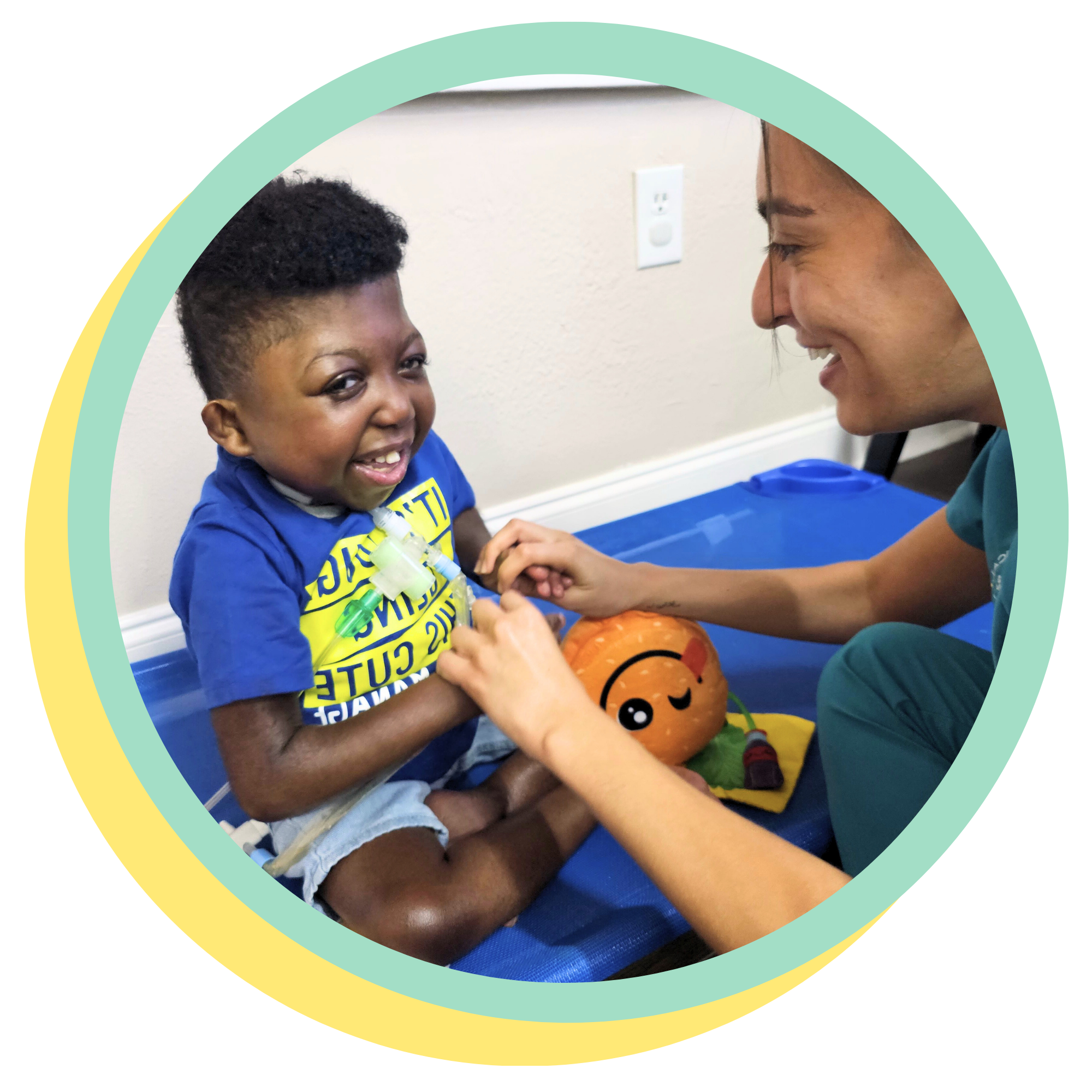Pediatric Evaluation & Therapy Services
Speech Therapy • Physical Therapy • Occupational Therapy • Feeding Therapy • Myofunctional Therapy

Comprehensive Evaluations
We’ll start with a comprehensive evaluation to learn more about your child’s unique abilities and any developmental challenges that they may need support with. Evaluations typically include:
Intake forms
Parent interviews
Child observations
Formal assessments
Once the evaluation is complete, we will collaborate with your family and other members of your child’s medical team to create a therapy plan. Your therapist will contact you to share the results, discuss your family’s goals, and send a formal report to you and your child's physician.
Our Approach to Therapy
At Sunshine S.P.O.T., our pediatric therapists make learning feel like play! We incorporate your child’s interests into sessions and build skills during motivating activities such as:
Arts, crafts, and music
Turn-taking games
Imaginative play with toys
Movement activities
Your family’s needs, values, and goals drive our sessions, so you’ll be involved from the very beginning. We’ll provide you with simple home-based activities that you can use in your daily routines and partner with all members of your child's medical team to get the best outcomes from therapy.
Speech therapy for kids
Speech therapy focuses on helping your child find their voice and communicate with confidence. Whether your child struggles with speech sounds, understanding others, or expressing themselves, our therapists make learning to communicate fun, playful, and meaningful!
Speech therapy will help your child:
Speak more clearly and confidently
Understand what others are saying
Use new words and sentences
Express wants, needs, and ideas using speech or AAC
Build social communication skills
-
At Sunshine S.P.O.T., we support children with the following communication challenges:
Late talkers
Language disorders
Speech sound disorders (articulation)
Use of Augmentative & Alternative Communication (AAC) methods and high-tech devices
Difficulty with reading and reading comprehension
Stuttering
Voice disorders
Difficulty with cognitive and executive functioning skills
Social communication challenges
-
Our speech therapy sessions are play-based! We use toys, games, books, crafts, and other motivating activities to help your child acquire new speech and language skills.
Your speech therapist will also provide your family with exercises that you can do on your own at home to support your child's progress in daily life.
-
Our sessions are always focused on your child’s individual needs and your family’s goals. When your child attends speech therapy at Sunshine S.P.O.T., you can expect to see positive outcomes such as:
Behavioral improvements: Using words to express wants and needs, and appropriately sharing emotions.
Enhanced language skills: New vocabulary, complete sentences, and better language comprehension.
Improved school performance: Succeeding in academic tasks that require listening, speaking, reading, and writing.
Social skills: Understanding social cues, conversational rules, and how interact with other children.
Better quality of life: Developing confidence, independence, and self-esteem in daily life.
-
Yes! Sunshine S.P.O.T.'s speech-language pathologists are trained to help non-speaking and minimally-speaking children acquire high-tech Augmentative and Alternative Communication (AAC) devices.
We have professional relationships with AAC companies including PRC-Saltillo, AbleNet, Tobii Dynavox, and Lingraphica.
Physical therapy for kids
Physical therapy helps children build strength, coordination, and confidence to move through life with ease. While your child plays and navigates obstacle courses, our PTs will provide skilled support to help them move with more confidence and less pain.
Physical therapy will help your child:
Reach gross motor milestones at their own pace
Improve balance, stability, and control
Build confidence to try new movements
Decrease physical discomfort or fatigue
Independently participate in daily routines
-
Pediatric PT is for children of all ages who have movement disorders, developmental delays, or orthopedic conditions. At Sunshine S.P.O.T., our physical therapists support challenges related to:
Developmental delays or disabilities
Cerebral palsy and other movement disorders
Congenital conditions
Neuromuscular disorders
Injuries or orthopedic conditions
-
Our physical therapy sessions are fun, playful, and personalized! We use toys, games, and obstacle courses to help children develop the skills they need to thrive.
Your physical therapist will also provide your family with simple exercises you can do during daily routines like mealtimes, grocery shopping, and bath time to support your child's progress outside of sessions.
-
Our sessions are always focused on your child’s individual needs and your family’s goals. When your child attends physical therapy at Sunshine S.P.O.T., you can expect to see positive outcomes such as:
Better coordination: More controlled movements.
Gross motor skills: Crawling, walking, running, and jumping with ease.
Reduced stiffness: Improved flexibility, mobility, and range of motion.
Stronger muscles: Gaining strength to roll, crawl, stand, walk, play, run, jump, and move in daily life.
Improved balance: Maintaining balance and reducing the risk of falls and injuries.
Improved stamina: Endurance for work and play.
Pain relief: Less pain during daily life activities.
Social participation: Building confidence, self-esteem, and social connections with other children.
-
Yes! Sunshine S.P.O.T.'s pediatric physical therapists are skilled in assessing, ordering, and fitting a variety of orthotics and adaptive equipment to support each child’s unique needs, including:
Activity chairs to provide a stable and supported sitting position for all activities.
Crutches and canes to assist with balance and stability.
Lifts and slings for safe transfers.
Walkers and gait trainers to provide support for walking.
Wheelchairs, including manual or power-driven options.
Orthotics, including braces, splints, and shoe inserts.
Positioning wedges and mats to help with stability and head control.
Protective helmets to ensure safety.
Specialized car seats and transport equipment to support proper positioning during travel.
Standers to provide a supported standing position.
Occupational therapy for kids
Occupational therapy helps children build the skills they need for everyday success, from getting dressed and feeding themselves to managing emotions and participating in school. Our OT sessions will give your child the confidence to play, learn, and care for themselves!
Occupational therapy will help your child:
Reach fine motor and gross motor milestones
Regulate emotions and manage frustration
Complete daily activities like feeding, dressing, and writing
Gain independence at home and school
Strengthen coping skills for sensory and behavioral challenges
-
At Sunshine S.P.O.T., we support children with challenges related to:
ADHD
Autism Spectrum Disorders
Cognitive delays
Coordination challenges
Daily living activities
Developmental delays
Fine motor skills
Handwriting
Learning disabilities
Difficulty with self-care tasks
Self-regulation challenges
Sensory processing disorder
Social and emotional issues
Variety of medically fragile conditions or syndromes
-
Pediatric occupational therapy is a fun learning experience! Our sessions will help your child reach their goals during play and everyday activities.
Your occupational therapist will also provide your family with exercises that you can do on your own at home to support your child's progress in daily life.
-
Our sessions are always focused on your child’s individual needs and your family’s goals. When your child attends OT at Sunshine S.P.O.T., you can expect to see positive outcomes such as:
Self-regulation: Managing emotions and learning to improve sensory and behavioral regulation.
Better school performance: Completing academic tasks with greater focus, accuracy, and independence.
Enhanced cognitive skills: Improving attention, memory, and problem-solving skills.
Sensory processing: Tolerating different textures, sounds, or movements.
Fine motor skills: Improving dexterity for daily skills like handwriting, cutting, and buttoning clothes.
Gross motor skills: Improving balance and coordination.
Increased independence: Performing self-care tasks without prompting.
Social skills: Confidently interacting with other children and adults.
-
Yes! Sunshine S.P.O.T.'s occupational therapists are trained to help acquire:
Adaptive equipment including adaptive utensils, seating, and mobility devices.
Ankle-Foot Orthoses (AFOs) to help stabilize the foot and ankle.
Hand and arm splints to support, protect, or improve the range of motion in a child's hand, wrist, or arm.
Neoprene splints to provide gentle compression and support for joints without restricting movement entirely.
Feeding therapy for kids
Feeding therapy helps your whole family enjoy mealtimes by creating safe and adventurous eaters. Using gentle, family-centered strategies, our feeding therapists will support your child as they try new foods, overcome sensory aversions, and learn to swallow safely.
Feeding therapy will help your child:
Safely chew, swallow, and self-feed
Overcome picky eating and try new foods without fear
Strengthen oral motor and sensory skills
Reduce stress, battles, and behaviors related to eating
Create happier, calmer mealtimes for the whole family
-
At Sunshine S.P.O.T., we support children with the feeding challenges related to:
Poor oral-motor coordination
Picky eating and limited food variety
Mealtime behaviors
Posture and positioning issues
Self-feeding skills
Sensory aversions
Suck-swallow-breathe patterns
Swallowing disorders (Dysphagia)
Transitioning to solid foods
Underlying medical conditions
-
Feeding problems are complex and can stem from many different factors— like sensory challenges, oral motor issues, or a negative past experience with food. Feeding therapy addresses the root causes of feeding difficulties, which may be behavioral, sensory, or physical.
-
At Sunshine S.P.O.T., we make sessions stress-free through play-based learning, and support families with techniques they can use on their own at home during meal times.
Our gentle approach ensure that children feel safe and in control during feedings. First, your child might need to tolerate a new food on their plate, then perhaps touch or smell it, and eventually, they may feel ready to taste it.
Sunshine S.P.O.T.'s pediatric speech-language pathologists and occupational therapists work together to get the best outcomes in feeding therapy.
-
Our sessions are always focused on your child’s individual needs and your family’s goals. When your child attends feeding therapy at Sunshine S.P.O.T., you can expect to see positive outcomes such as:
Less sensory sensitivities: Tolerating different tastes, textures, and smells.
More diet variety: Eating a wider variety of foods and being open to trying new foods.
Better growth and nutrition: Eating nutritious foods and establishing long-term healthy eating habits.
Oral motor skills: Ability to suck, chew, and move food around in the mouth.
Reduced risk of aspiration: Coordinating breathing and swallowing to reduce the risk of choking.
Less resistance and challenging behaviors: Reducing food refusal, tantrums, and negative behaviors.
Happy mealtimes: Less stress and more joy at mealtimes, resulting in a positive relationship with food and family.
Myofunctional Therapy for Kids
Myofunctional therapy is like physical therapy for the muscles of the face, mouth, and tongue. Our sessions combine play and structured oral exercises to improve your child’s overall health.
Myofunctional therapy will help your child:
Achieve proper breathing (through the nose)
Experience quality sleep
Reduce tension in the facial muscles
Speak clearly without speech sound errors
Enhance cranio-facial development
-
Chewing with an open mouth
Dental and oral habits
Difficulty breathing through the nose
Difficulty closing the lips to swallow
Difficulty or messiness while eating or drinking
Difficulty saying certain sounds
Drooling
Facial grimacing or pursing the lips to swallow
Food crumbs or liquid crumbs lodged in the mouth corners
Frequent stomach aches
Low lip tone
Open mouth posture while eating and swallowing
Tongue thrusting, where the tongue pushes against the teeth during swallowing
Open mouth rest posture
Open bite, overbite, underbite, or other malocclusion
Poor sleep
Speech distortions
Thumb sucking
Tongue-tie or lip-tie
Weak lip muscles
-
We begin myofunctional therapy at age 3.
-
Sunshine S.P.O.T.'s pediatric speech-language pathologists treat a variety of orofacial myofunctional disorders. We collaborate with other medical providers to address functional issues such as:
Low tongue posture
Messy eating
Mouth breathing
Open-mouth posture
Oral habits like thumb or pacifier sucking
Persistent speech sound errors
Swallowing difficulties
Tongue thrust
-
Yes! Sunshine S.P.O.T. has a certified lactation consultant on our team who can help families manage tongue ties with non-surgical intervention. Contact us to learn more!
We’re accepting new clients in the tampa bay area!
Sunshine S.P.O.T. provides family-centered therapy services for kids in Hillsborough, Pasco, and Pinellas Counties. We’ll meet you at home, online, at school, in daycare, or on-site at Specialized Care Pediatrics PPEC!











